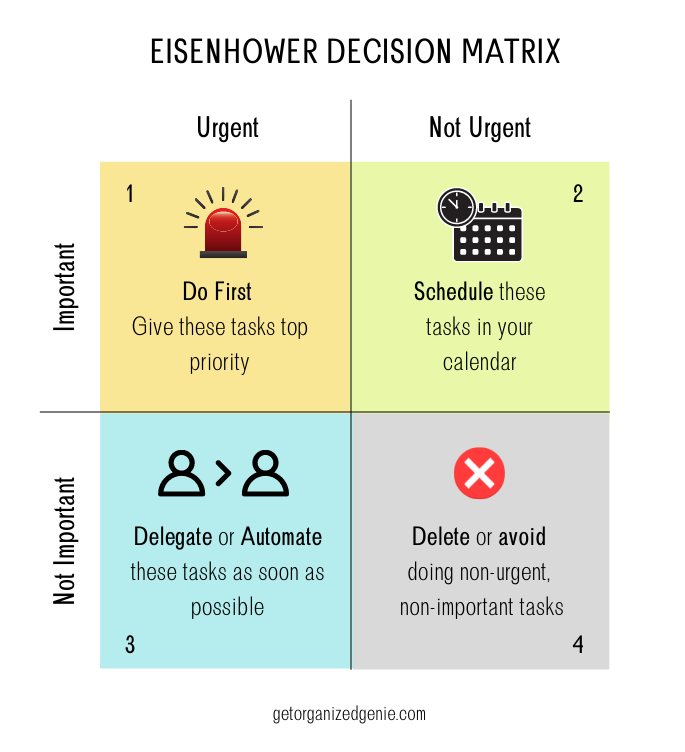- Home
- Increase Productivity at Work
- Eisenhower Decision Matrix
Eisenhower Decision Matrix: How to be More Productive by Prioritizing the Important
The Eisenhower Decision Matrix is a
task management tool that can help you to organize and prioritize tasks, taking
into consideration their urgency and importance.
Being able to make a clear distinction between urgent and important tasks, and addressing them appropriately is essential for effective time management and achieving high productivity.
This article will show you how to use the Eisenhower Decision Matrix to prioritize your workload and boost productivity with ease.
Read on to find out how to get more stuff done without
stress and overwhelm.
Origin of the Eisenhower Decision Matrix
The Eisenhower Decision Matrix stems
from a quote stated by Dwight D. Eisenhower, the 34th president of the United
States.
On the 19th of August 1954, during his speech(1) at the Second Assembly of the World Council of Churches, Eisenhower quoted the words of a former college president: "I have two kinds of problems, the urgent and the important. The urgent are not important, and the important are never urgent".
Eisenhower was renowned for his organizational, planning, and leadership skills, which he demonstrated fully throughout his professional career.
During World War II, Eisenhower served as Supreme Commander of the Allied Expeditionary Force and was a 5-star General of the Army. After the war, he served as the Army Chief of Staff, later as President of Columbia University, and was the first Supreme Commander of NATO.
In 1953, Eisenhower became President of the United States and spent two terms in office.
Eisenhower's insights on
distinguishing between "the urgent" and "the important" for
prioritizing tasks, were used to develop the Eisenhower Decision Matrix.
What is the Eisenhower Decision Matrix?
The Eisenhower Decision Matrix, also
known as the Eisenhower Matrix, Eisenhower Box, Urgent-Important Matrix, Eisenhower Productivity
Matrix, and Eisenhower Prioritization Matrix, is a matrix with four quadrants.
The X-axis of the matrix is labeled
"Urgent - Not Urgent" and the Y-axis "Important - Not
Important".
Quadrant 1 (Upper Left)
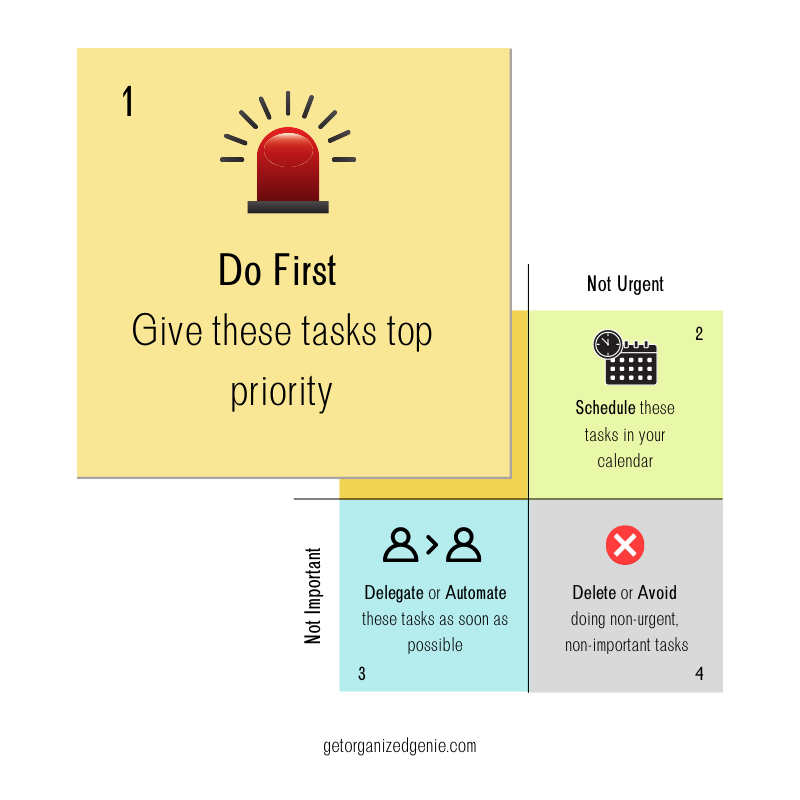
Quadrant 1 of the Eisenhower Decision Matrix applies to tasks that are urgent and important. This includes tasks that have an approaching deadline or a crisis that can have serious consequences if not addressed immediately. These are usually things that appear unexpectedly or things that you have been putting off for a while and now have a looming deadline.
Tasks in Quadrant 1 should be given the highest priority and addressed before moving on to tasks in the other quadrants.
Examples include:
- Your car breaks down on the way to work and needs urgent repair.
- Picking up your ill child from school.
- A client contacts you about an issue that needs to be addressed urgently.
- You have to cover for a sick colleague.
- A report for your boss needs to be submitted today.
Although Quadrant 1 tasks need to be
addressed immediately, be careful to ensure that these tasks don't completely
eclipse Quadrant 2 tasks which are less urgent, but in many cases may be
equally or more important than Quadrant 1 tasks.
Quadrant 2 (Upper Right)
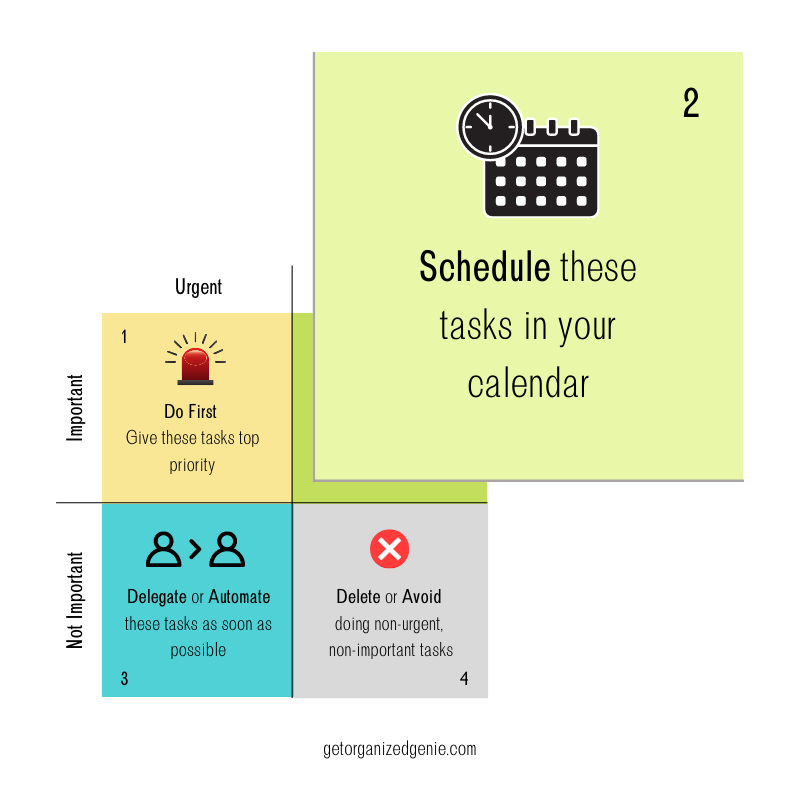
Quadrant 2 of the Eisenhower Decision Matrix applies to tasks that are important but not urgent. Although these tasks do not have an approaching deadline, they play an important role in achieving long-term goals.
Tasks in Quadrant 2 should not be postponed for too long, as they may impact future progress. Schedule these tasks so that they can be addressed at an appropriate time.
Quadrant 2 tasks or projects are those that can help you to reach your personal, professional, or business goals, such as:
- Planning and organizing your workload.
- Strategic planning.
- Career planning and professional development.
- Attending training courses and educational events.
- Routine maintenance tasks.
- Regular self-care.
Quadrant 2 tasks usually require careful thought, planning, and a considerable amount of time and effort. This makes procrastination on them in favor of urgent or less difficult tasks far more likely.
According to Stephen Covey, author of the best-selling book "The 7 Habits of Highly Effective People", we should focus our time on tasks in Quadrant 2, prioritizing activities that improve our skills and personal development.
By consistently working on Quadrant 2 tasks, we are more likely to achieve important goals.
Although items assigned to this
quadrant are not time-sensitive, they should be addressed appropriately to
prevent them from ending up in Quadrant 1 - Urgent and Important.
Quadrant 3 (Lower Left)
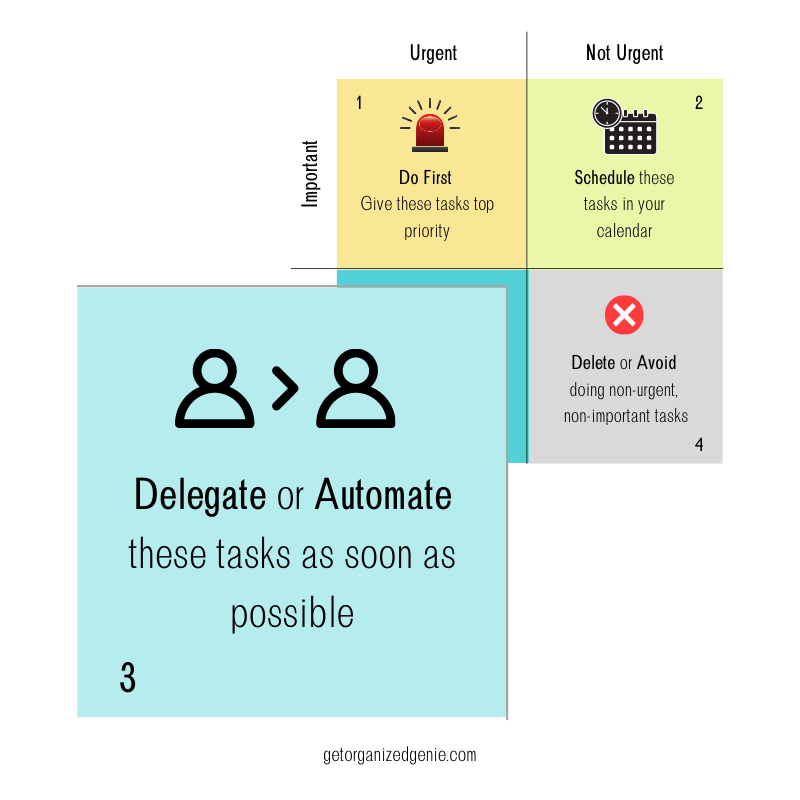
Quadrant 3 of the Eisenhower Decision Matrix applies to tasks that are urgent but not important. These tasks need to be addressed with urgency, but not necessarily by you.
The following tasks apply to Quadrant 3:
- Urgent equipment repair at a factory.
- Requests for help from work colleagues.
- Urgent emails.
- Attending an urgent meeting.
Tasks in this quadrant are usually ones that address someone else's priorities but don't help you to achieve your long-term goals. Whenever possible delegate these tasks.
If delegation is not possible, consider using the following strategies:
- Find out from the person in question the real urgency of the task. Do they require a response today, or can it wait until tomorrow? Sometimes people set a specific deadline to make sure that they have information in their possession, but won't necessarily do anything with it straight away.
- Learn to say no! If you are already snowed under with work, say so. No one will hold it against you.
- Address Quadrant 3 tasks during periods
when your energy levels are low. Reserve periods when your energy levels are
highest for tasks in Quadrants 1 and 2.
- It may be possible to automate certain tasks such as making payments, electronic backups, scheduling posts, etc.
Quadrant 4 (Lower Right)
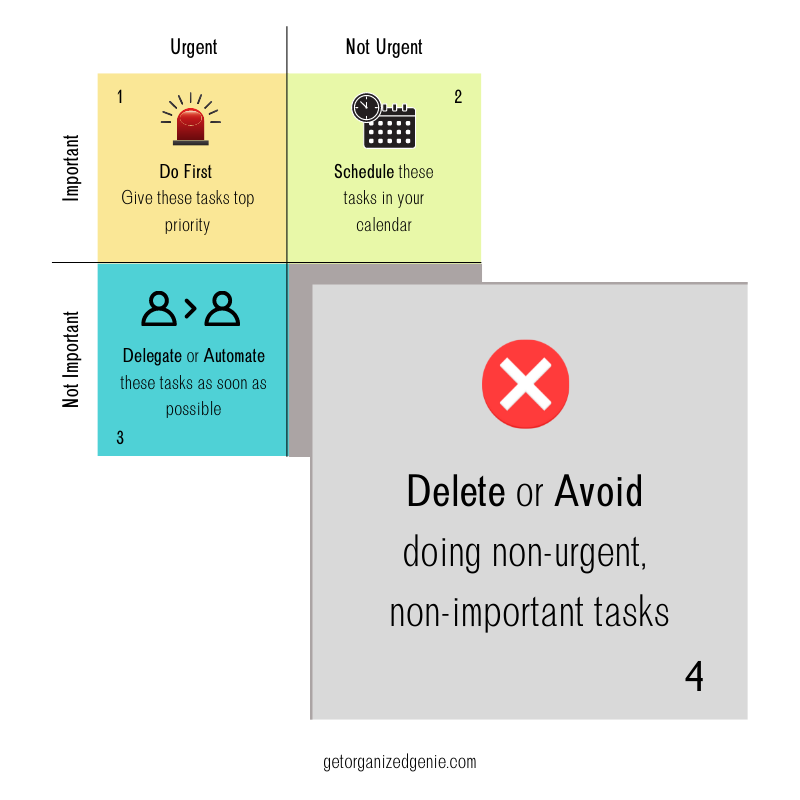
Quadrant 4 of the Eisenhower Decision Matrix is for tasks that are neither urgent nor important. This refers to the tasks you would do if you were to have lots of available time and resources (which is rarely the case!).
Before deciding whether a task should go into this quadrant, ask yourself the following questions:
- Does this task contribute to my long-term goals?
- Is it really necessary for me to do this?
- Are there any serious consequences of not doing this?
- If your answer to these three questions is No, you can delete these tasks without giving them any further thought!
Quadrant 4 tasks include:
- Tasks that contribute little or nothing to achieving your long-term goals.
- Some subscription emails.
- Time-consuming "nice-to-haves".
Quadrant 4 also applies to
time-wasting activities that we may succumb to throughout the day such as:
mindlessly browsing the internet, checking social media, playing with apps on
our mobiles, etc. Making a conscious effort to reduce or eliminate these activities
can greatly improve our productivity.
Download Your FREE Eisenhower Matrix Printable
Start prioritizing your tasks like a Pro and get more stuff done!
Download
your FREE Eisenhower Matrix Printable Template.
BOTTOM LINE
The Eisenhower Decision Matrix is a useful tool to help you to prioritize the tasks that really matter and eliminate those that don't.
Practice using it to manage your time more effectivity and observe a marked improvement in your productivity!
Further Reading
Check out the following articles to help you become better organized and productive. Make more time for YOU!
- How to Increase Productivity at Work
- FREE Eisenhower Matrix Printable Template.
- Eat That Frog Method to Stop Procrastination and Boost Productivity
- Getting Organized at Work - 4 Essential Tips for Success
References
Share this with others by clicking the icons below!
